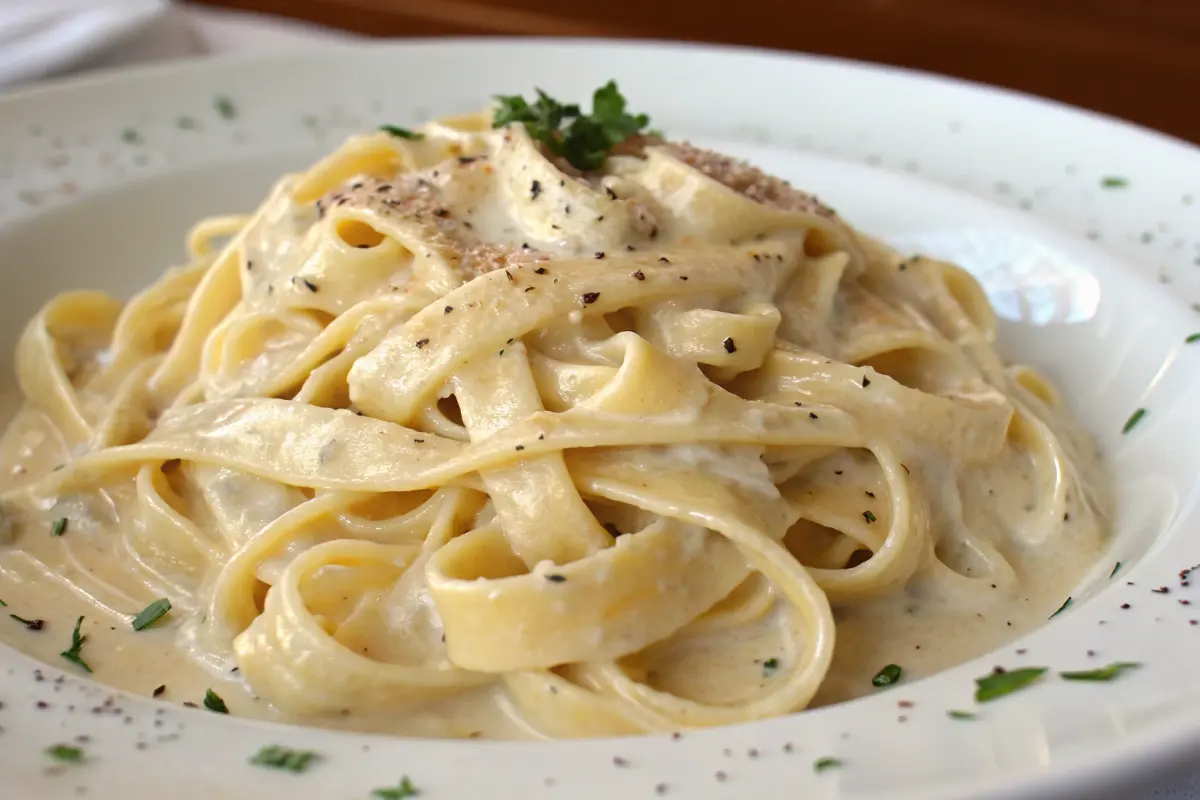Fettuccine Alfredo is one of those iconic dishes that combines simplicity with indulgence. With its creamy, buttery sauce enveloping tender pasta, it’s no wonder this dish has a dedicated following. But have you ever wondered about the origins of this dish or how to prepare it to perfection? Let’s dive into the essential tips and tricks for mastering Fettuccine Alfredo.
1. The History and Origins of Fettuccine Alfredo
To truly appreciate Fettuccine Alfredo, understanding its roots is essential. The dish was created by Italian restaurateur Alfredo di Lelio in the early 20th century. The original version was a simple mix of butter, parmesan cheese, and fettuccine, designed to cater to the needs of his pregnant wife, who had lost her appetite.
It was such a hit with diners that it soon became a staple in Italian cuisine, but its international fame came when Hollywood stars, including Mary Pickford and Douglas Fairbanks, visited the restaurant in Rome and raved about the dish. Over time, Fettuccine Alfredo became synonymous with indulgence and comfort, thanks to its rich, creamy texture.
2. The Secret to Perfect Fettuccine
The foundation of a great Fettuccine Alfredo lies in the pasta itself. The type of fettuccine you choose plays a crucial role in the overall dish. Traditional fettuccine is made with egg and flour, and it’s wide enough to hold the creamy sauce perfectly. Fresh, homemade fettuccine will yield the best results, but store-bought options work well when cooked properly.
Choosing the Right Fettuccine
When buying fettuccine, look for high-quality pasta made with durum wheat semolina. It holds up better to cooking, giving you that desired bite. Fresh pasta, while delicate, will cook faster than dried, so keep an eye on it to avoid overcooking.
Cooking Fettuccine to Perfection
Cooking pasta might seem straightforward, but there’s an art to getting it just right. Always cook your fettuccine in plenty of salted water, as it’s essential for flavor. Be sure to stir occasionally to prevent sticking, and taste it a minute or two before the recommended cook time to ensure it’s al dente. Drain the pasta, but save some of the cooking water. This starchy water can be added to the Alfredo sauce for a silkier texture.
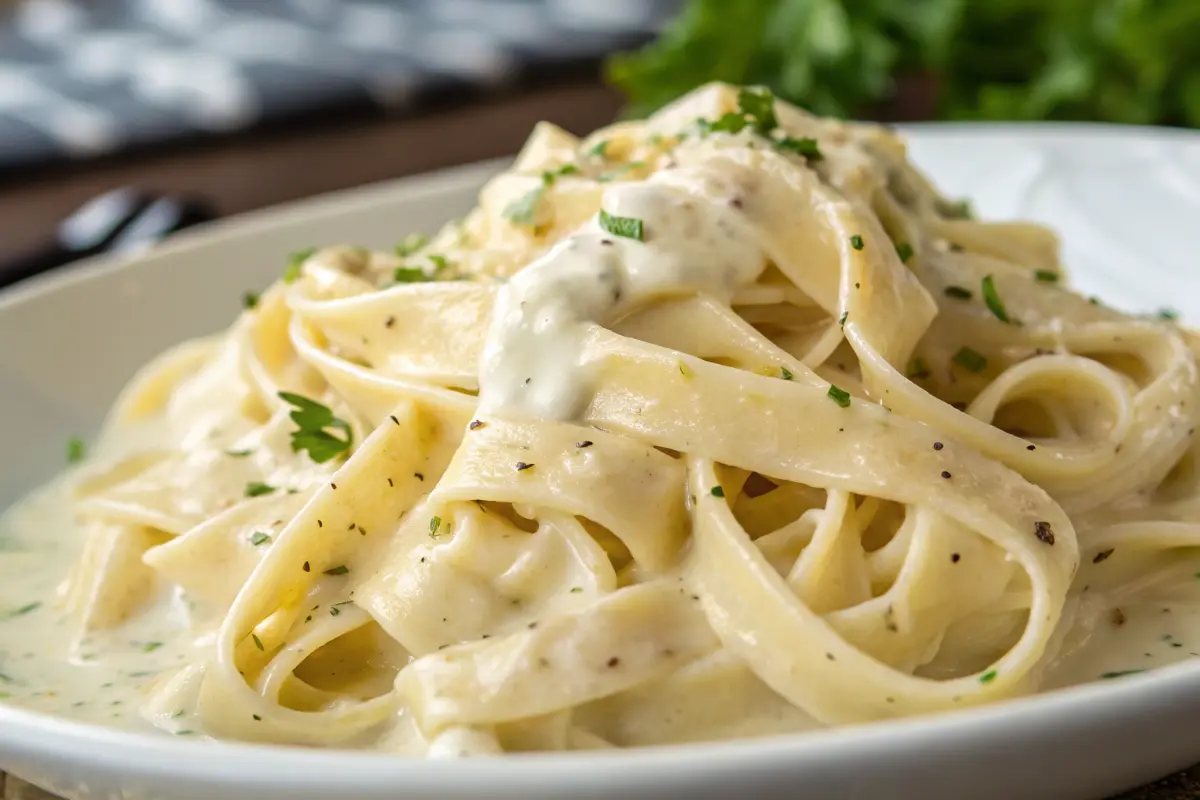
3. The Magic of Alfredo Sauce
Arguably, the sauce is what makes Fettuccine Alfredo unforgettable. It’s a rich, creamy concoction made with butter, cream, and Parmesan. The secret lies in achieving a perfectly smooth sauce with just the right balance of flavors.
Key Ingredients for a Rich and Creamy Sauce
To get the signature Alfredo sauce, start with butter—unsalted is preferred, as it allows you to control the seasoning. Add heavy cream to give it that velvety texture, and don’t forget a generous amount of freshly grated Parmesan cheese. The quality of the cheese makes a significant difference; opt for Parmigiano-Reggiano for an authentic and savory taste.
Tips for a Smooth, Lump-Free Sauce
To ensure your Alfredo sauce is silky smooth, it’s essential to melt the butter and cream together gently over medium heat. Add the grated Parmesan cheese slowly, stirring constantly to prevent clumping. Keep the heat low to avoid separating the cream, and if the sauce is too thick, thin it out with a little bit of the reserved pasta cooking water.
Elevating Your Fettuccine Alfredo Experience
Now that we’ve covered the essential elements of making Fettuccine Alfredo, let’s dive into some variations and ways to elevate the dish, ensuring that every bite is bursting with flavor and creativity. Whether you’re looking to experiment with proteins or want to make a dairy-free version, there are plenty of ways to keep things exciting while staying true to the dish’s core.
4. Variations on the Classic Fettuccine Alfredo
While the traditional Fettuccine Alfredo is a timeless classic, that doesn’t mean you can’t have a little fun with it. With so many options for variations, you can easily transform this dish to suit different tastes, dietary preferences, or occasions.
Chicken Alfredo, Shrimp Alfredo, and More
One of the most popular variations of Fettuccine Alfredo is Chicken Alfredo. Simply add grilled or pan-seared chicken breasts on top of the pasta for a hearty and satisfying meal. The richness of the Alfredo sauce pairs beautifully with the savory chicken, creating a balanced dish.
If you’re a fan of seafood, Shrimp Alfredo is another excellent variation. Tender shrimp sautéed in butter and garlic can take your dish to new heights. The sweetness of the shrimp adds a delightful contrast to the creamy sauce, making each bite an indulgence.
For those who love variety, you can also mix in other proteins like bacon, sausage, or even lobster for an extravagant twist. These proteins not only change the flavor profile but also offer a unique texture, making the dish more filling and satisfying.
Vegan and Dairy-Free Alternatives
If you or your guests are following a vegan or dairy-free diet, you can still enjoy a version of Fettuccine Alfredo without compromising on flavor. The key is to use plant-based ingredients while maintaining the creaminess and richness that make this dish so beloved.
For the sauce, replace heavy cream with coconut cream, almond milk, or cashew cream for a similar texture and consistency. Nutritional yeast can be used as a cheese substitute, offering that cheesy, umami flavor without any dairy. Tofu or vegan cream cheese can also provide the richness needed to replicate the traditional Alfredo sauce, so you don’t miss out on that luxurious mouthfeel.
As for the pasta, there are plenty of gluten-free or whole-wheat alternatives if you prefer a healthier option. Additionally, zoodles (zucchini noodles) or other vegetable-based noodles are great choices for a low-carb, nutrient-packed version of this dish.
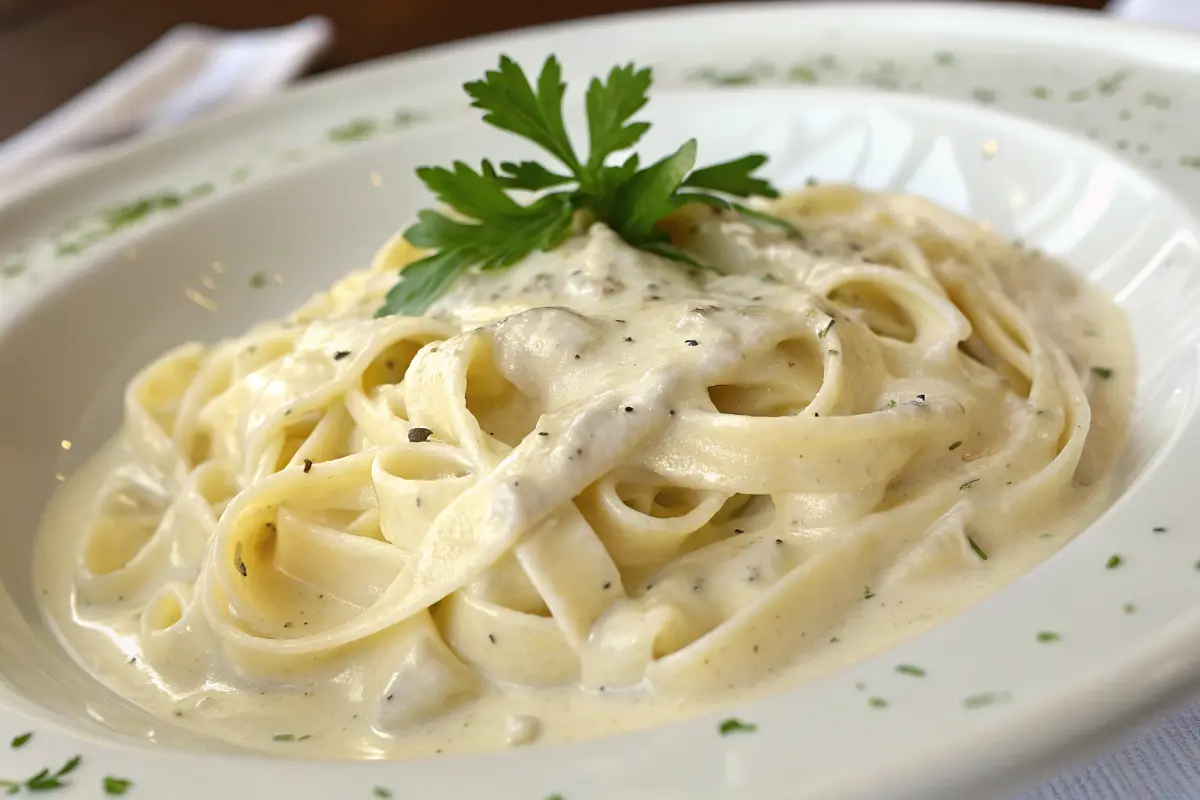
5. Serving and Pairing Fettuccine Alfredo
Fettuccine Alfredo is undeniably decadent on its own, but there are ways to elevate its presentation and pairings to make the meal even more indulgent.
Garnishing and Presentation Tips
One of the simplest ways to make your Fettuccine Alfredo look even more appetizing is through thoughtful garnishing. A sprinkle of fresh parsley or basil adds a pop of color and a refreshing herbal note that contrasts nicely with the richness of the sauce. A dash of freshly cracked black pepper can also give the dish an added kick.
If you want to take your presentation a step further, consider adding some grated Parmigiano-Reggiano over the top, along with a few slivers of freshly shaved truffle if you’re feeling fancy. Truffle oil is another luxurious touch, enhancing the dish with its earthy aroma and flavor.
Another fun garnish idea is toasted breadcrumbs. Lightly toast some breadcrumbs with olive oil and garlic, then sprinkle them on top of your pasta. The crunch adds texture to the creamy dish, giving it a delightful contrast.
Perfect Wine Pairings and Sides
Fettuccine Alfredo pairs wonderfully with a variety of wines, thanks to its rich and creamy profile. If you’re serving the classic version with butter and cream, a crisp white wine like Chardonnay or Pinot Grigio will complement the richness of the sauce without overwhelming it. For those who prefer red wine, a light Pinot Noir can offer a subtle contrast without clashing with the flavors.
As for sides, a simple green salad with a tangy vinaigrette can help balance out the heaviness of the dish. The acidity from the dressing will cut through the creaminess, refreshing your palate between bites. Garlic bread or a baguette is also a popular accompaniment, perfect for dipping into the leftover Alfredo sauce.
If you’re feeling adventurous, roasted vegetables like asparagus or Brussels sprouts provide a nice contrast of textures and flavors. These vegetables also add a pop of color, making the meal more visually appealing.
6. Common Mistakes to Avoid When Making Fettuccine Alfredo
To ensure your Fettuccine Alfredo turns out as creamy and satisfying as possible, here are a few common mistakes to watch out for when preparing the dish:
Overcooking the Pasta
Fettuccine can quickly become mushy if it’s overcooked. Always cook the pasta al dente, which means it should still have a slight bite when you taste it. Remember, the pasta will continue to cook slightly when mixed with the sauce, so it’s best to err on the side of undercooking.
Using Pre-Grated Cheese
While pre-grated Parmesan cheese may be convenient, it often lacks the flavor and texture of freshly grated cheese. Pre-grated cheese tends to have anti-caking agents that can affect the smoothness of your sauce. Grating your own Parmesan from a block ensures a creamier texture and a more authentic flavor.
High Heat for the Sauce
When preparing the Alfredo sauce, avoid using high heat. Heating the cream and butter too quickly can cause them to separate or curdle, ruining the texture of the sauce. It’s best to keep the heat low and stir frequently for a smooth, velvety finish.
Neglecting the Pasta Water
Don’t forget to save some of the pasta water when draining the fettuccine! This starchy water helps thin out the Alfredo sauce and adds a silky, cohesive texture. If the sauce seems too thick, simply add a splash of pasta water to bring it to the desired consistency.
Bringing It All Together – Mastering Fettuccine Alfredo
In this final part, we’ll wrap up with tips on preparing Fettuccine Alfredo ahead of time, answer some frequently asked questions, and offer practical advice for both beginners and seasoned chefs alike. By the end, you’ll be equipped to make this rich and indulgent dish a showstopper in your kitchen.
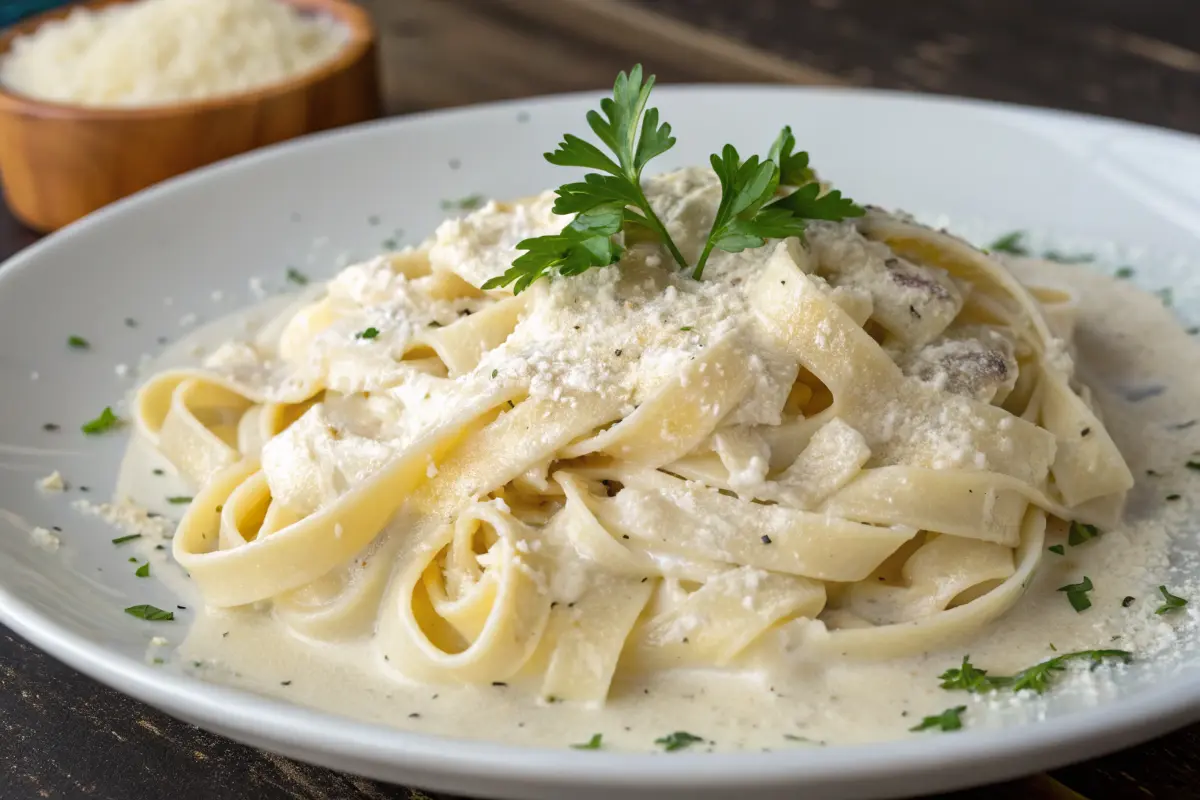
7. How to Make Fettuccine Alfredo Ahead of Time
If you’re planning to serve Fettuccine Alfredo for a special occasion or a busy weeknight, preparing it ahead of time can be a huge time-saver. Here are a few tips to help you prepare the dish in advance without sacrificing flavor or texture.
Pre-Cooking the Pasta
To start, cook the fettuccine pasta until it’s just underdone (al dente). Once it’s drained, toss it in a bit of olive oil to prevent it from sticking together. You can store this in an airtight container in the refrigerator for up to 24 hours.
Making the Sauce Ahead
The Alfredo sauce can also be made in advance. Simply prepare it as you normally would, but cook it slightly less than usual. When reheating, you can add a little extra cream or pasta water to bring it back to its original smooth consistency.
Reheating Tips
To reheat your pre-made Fettuccine Alfredo, it’s best to gently warm the pasta and sauce separately on the stovetop over low heat. Once they’re both warmed through, combine them and serve immediately. Be careful not to overheat the sauce, as this can cause it to break down.
8. Storing and Freezing Fettuccine Alfredo
If you have leftovers or want to prepare the dish in bulk for later, Fettuccine Alfredo can be stored or frozen for future meals. However, there are a few things to keep in mind to ensure the quality remains high.
Storing Leftovers
Once your Fettuccine Alfredo has cooled down, transfer it to an airtight container and store it in the refrigerator for up to three days. When reheating, you may need to add a splash of cream, milk, or pasta water to bring the sauce back to life, as it can thicken over time.
Freezing Fettuccine Alfredo
While you can freeze Fettuccine Alfredo, the texture may change slightly upon reheating. To freeze, allow the dish to cool completely, then transfer it to an airtight container or freezer-safe bag. When you’re ready to enjoy it, thaw the dish in the refrigerator overnight and reheat gently on the stove. Adding a little extra cream or milk can help restore the sauce’s creamy texture.
9. Frequently Asked Questions About Fettuccine Alfredo
Now, let’s answer some of the most common questions people have when making Fettuccine Alfredo.
1. Can I use a different type of pasta for Alfredo?
While fettuccine is the classic choice, you can use other pasta shapes such as linguine, spaghetti, or penne. Just keep in mind that the sauce will cling to different types of pasta in various ways, so choose one that holds up well with rich, creamy sauces.
2. Can I make Fettuccine Alfredo without heavy cream?
Yes! You can substitute heavy cream with alternatives such as whole milk, coconut milk, or even a blend of Greek yogurt and milk for a lighter version. Keep in mind that the texture will change, but you can still achieve a creamy consistency.
3. How can I add vegetables to Fettuccine Alfredo?
You can easily add vegetables like broccoli, peas, spinach, or mushrooms to your Fettuccine Alfredo. Lightly sauté the vegetables before mixing them with the pasta, or toss them in at the end. This not only adds nutrition but also enhances the flavor and texture.
4. Can I make Fettuccine Alfredo without butter?
Yes, you can make a butter-free Alfredo by using olive oil instead. The texture may differ slightly, but the olive oil will still provide a smooth, velvety sauce that pairs well with the creamy elements of the dish.
5. How do I thicken my Alfredo sauce?
If your Alfredo sauce is too thin, you can thicken it by simmering it for a few more minutes, allowing the cream to reduce. If you need a quicker solution, add a cornstarch slurry (a mix of cornstarch and water) to thicken the sauce immediately.
6. Can I make a dairy-free version of Fettuccine Alfredo?
Absolutely! You can make a dairy-free version of Fettuccine Alfredo by using plant-based substitutes like almond milk or cashew cream for the sauce. Nutritional yeast can also be used in place of Parmesan cheese, providing a cheesy flavor without any dairy.
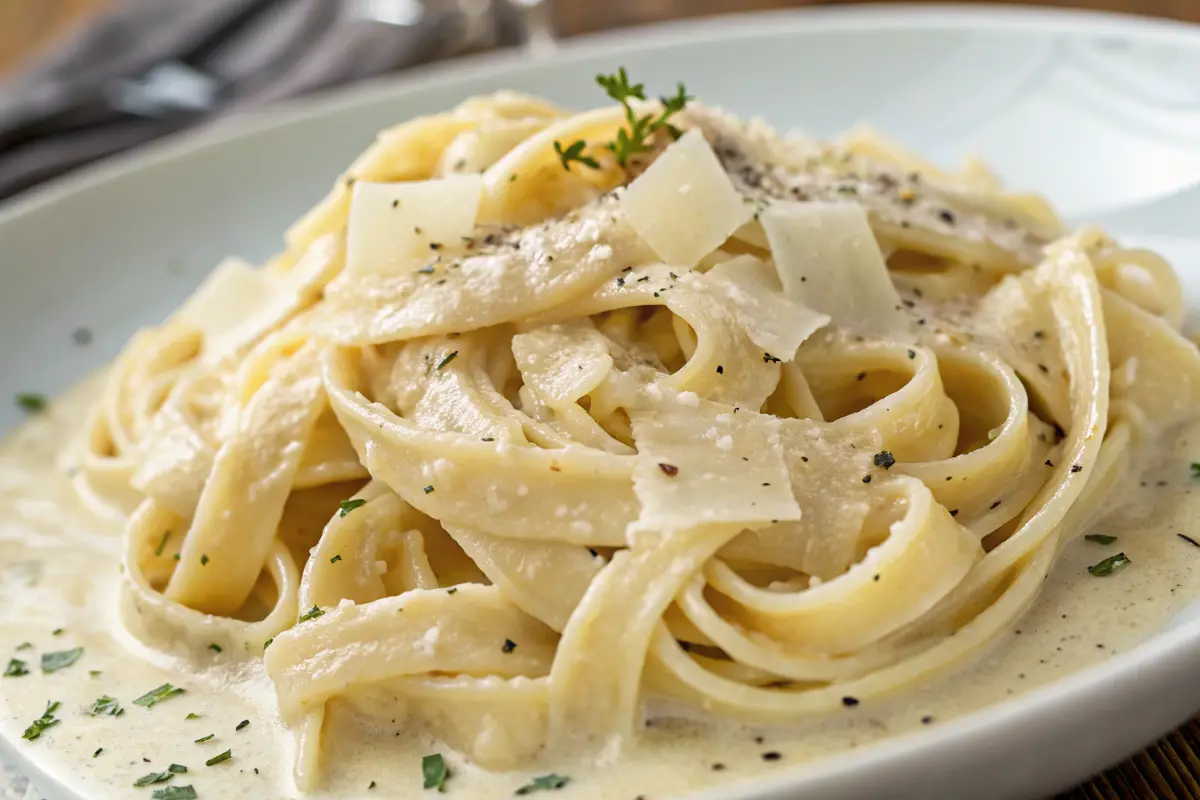
10. Conclusion: Fettuccine Alfredo – A Dish for Every Occasion
Fettuccine Alfredo is a dish that has stood the test of time due to its simplicity, decadence, and versatility. Whether you prefer the classic version or enjoy experimenting with different proteins, vegetables, and sauces, this dish is sure to please any palate. With the right ingredients, techniques, and a little creativity, you can create an Alfredo masterpiece that will leave your guests craving more.
Ready to master the art of Fettuccine Alfredo? Use the tips and tricks from this guide to create a creamy, irresistible dish that suits your taste. Whether you’re a beginner or a seasoned chef, grab your ingredients and start cooking—your perfect Alfredo awaits! ! Share your creations with us and inspire fellow food lovers!

